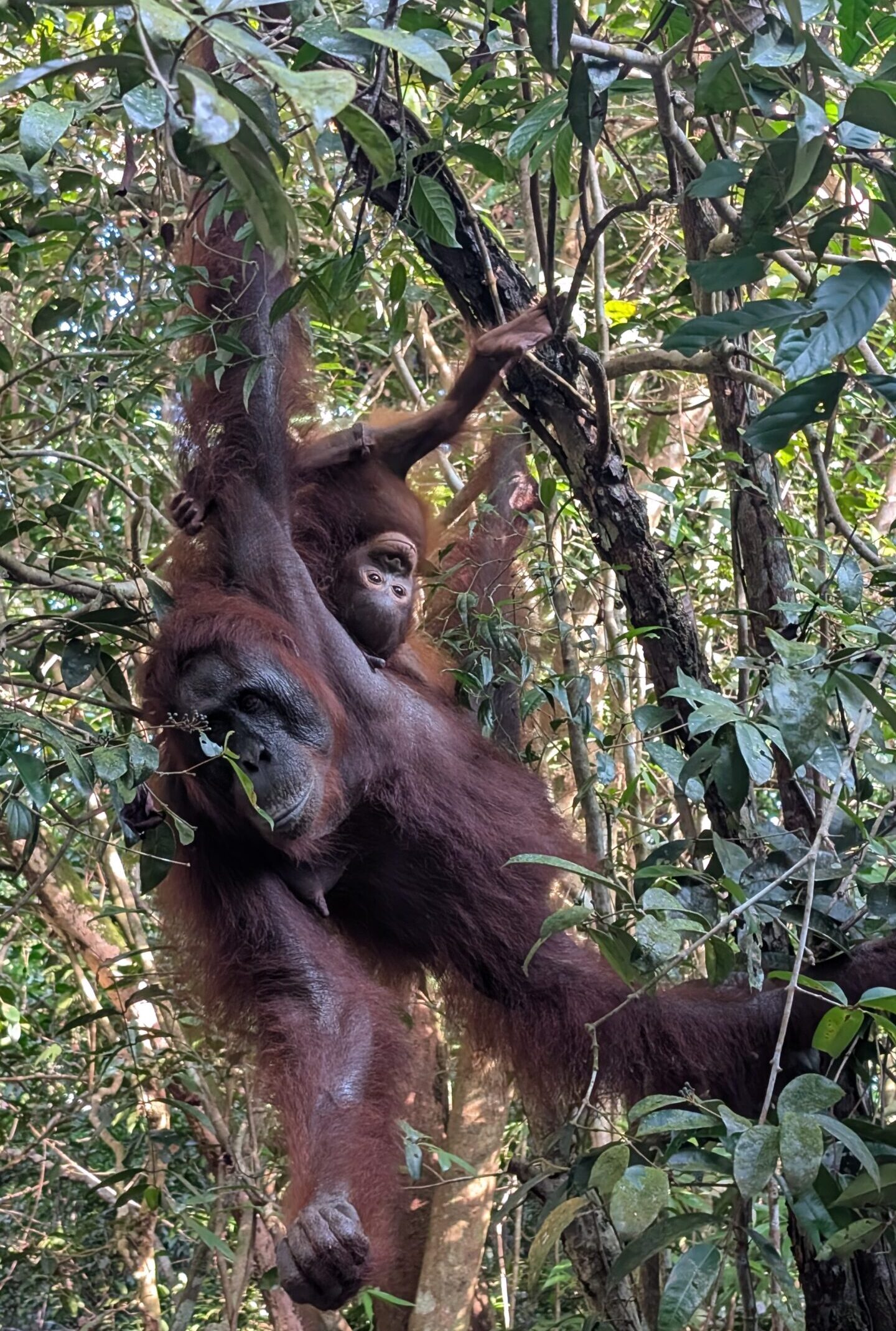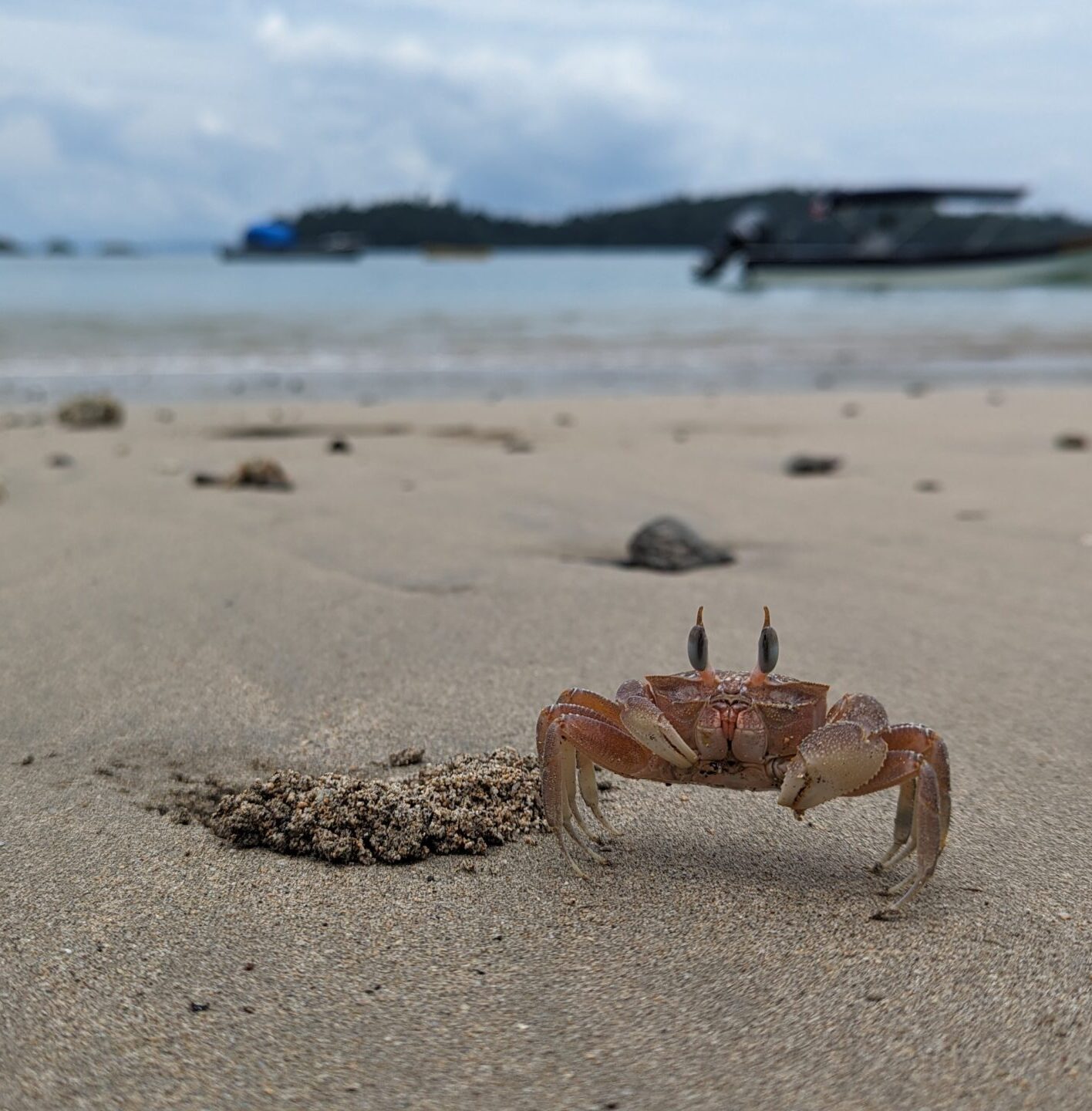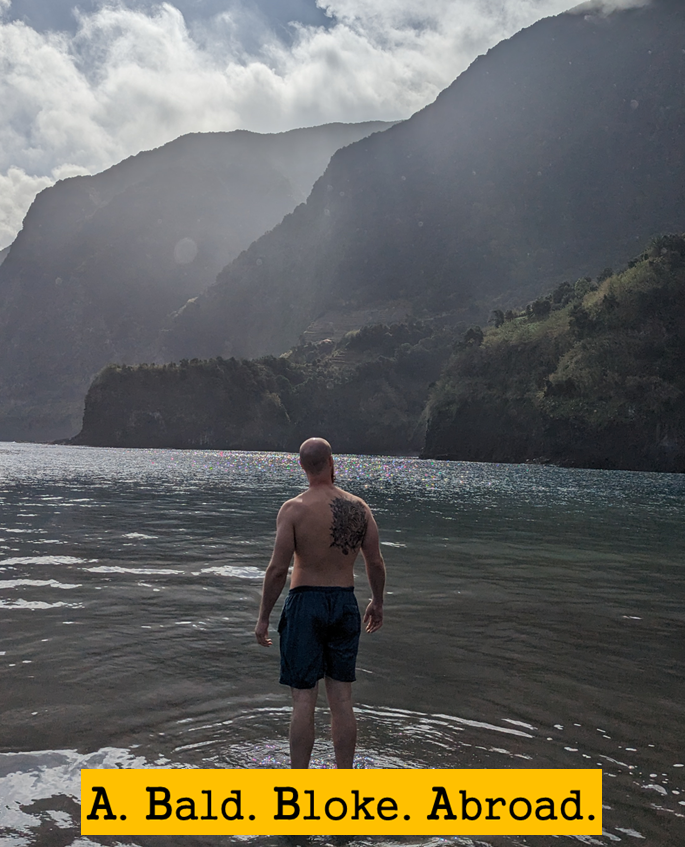Welcome to the Jungle: Tanjung Puting National Park
Our final stop in Indonesia came from a last-minute decision after our plans for Flores went sideways. Mary-Ann discovered a riverboat tour in Kalimantan online, the huge Indonesian chunk of Borneo. Over three days on a traditional ‘Klotok’ boat, we drifted down the Sekonyer River, snaking through Tanjung Puting National Park. It’s wild, very remote, and teeming with creepy crawlies and exotic critters, but aside from that, it’s best known for its orangutans!
The ‘Orangutan Foundation International,’ based in the park, was founded by three women: Dian Fossey (yes, the one supposedly murdered by poachers in Rwanda), Jane Goodall, and finally Birutė Galdikas – more on her later!
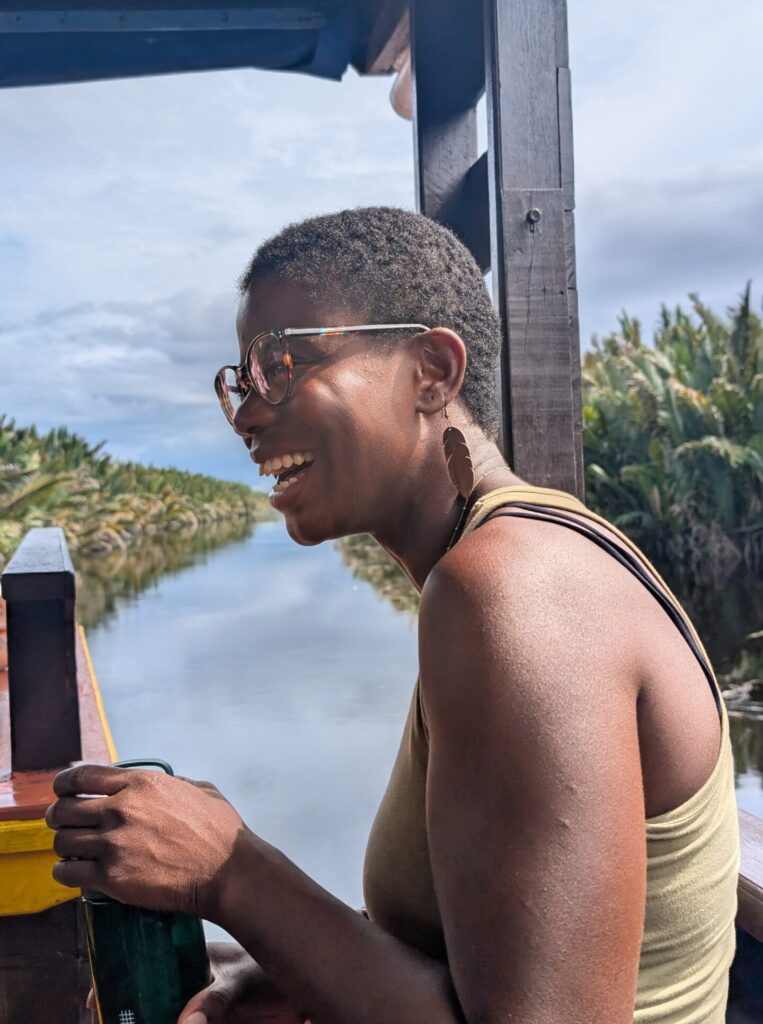
How to Get There
Kalimantan is enormous, and while a few in our group braved overnight buses from elsewhere on the island, most of us flew in from Jakarta. Flights run daily for about £60, landing at Iskander Airport near Pangkalan Bun, a town with few hotels and amenities. You can either fly in the day before or catch an early flight on the day of your tour.
Your operator should offer airport or hotel pick-up, but if not, book a private taxi to the port in Kumai. I don’t think it’s a place to risk getting lost in… There is a very noticeable military presence in the area. Better safe than sorry!
The Tour: Boats, Bananas, and Swamp Sludge
We booked our tour with ‘Be Borneo‘ and opted for a group trip to save money. It cost £122.50 per person, including the 3-day tour, food, park entry, and airport pick-up/drop-off. By the way, when they say “3 days,” it’s really 2 full days. Most of day 1 spent getting started, and day 3 wraps up surprisingly early.
Group size depends on the ‘Klotok’ boat. Ours had 10 people plus 4 crew (captain, staff, and a chef!). We did see couples and families on private tours, complete with candlelit dining under the stars and even tiny bars! Tempting, but from what we could tell, they started at £450 – quite a splurge! Our cramped quarters weren’t quite as luxurious… But, for people like us, who don’t mind becoming a bit of a hobo for a few days, it’s absolutely fine!
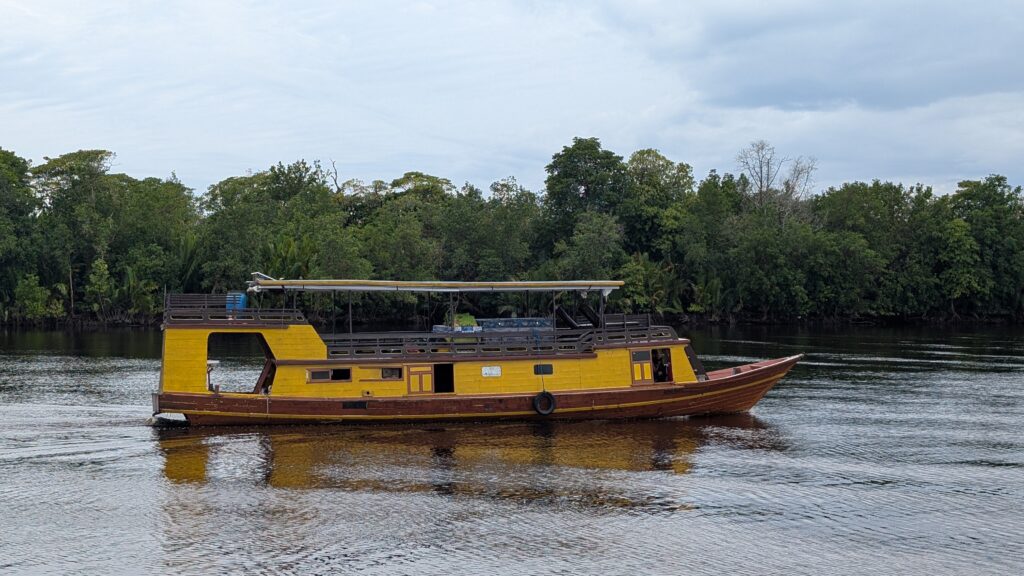
Pro Tip: Go during the ‘shoulder’ months, just before or after high season. We did our tour at the start of the wet season, so there were only six Klotok on the river in total. Three group tours (including ours) and three private ones. But even so, the mooring areas felt quite busy at the stops. In peak season, there can be up to 30 chugging around!
Tanjung Putting: Why’s it So Special?
It’s a vast area of protected rainforest in Indonesian Borneo. As I am sure you know, much of Borneo’s mature forest has been cleared for palm oil plantations – which really are as bad as those TV ads suggest. In some areas, rows of palm trees stretch as far as the eye can see in every direction. But, thankfully, the national park has been spared (mostly).
What makes Tanjung Puting truly special is its orangutans. The Bornean orangutan is the largest of the two species (the other being the Sumatran variety), with those distinctive flabby jowls – think Maurice from ‘Planet of the Apes’. Of course, the park is also home to loads more; countless bird species, the iconic proboscis monkey, crocodiles, pythons, etc…
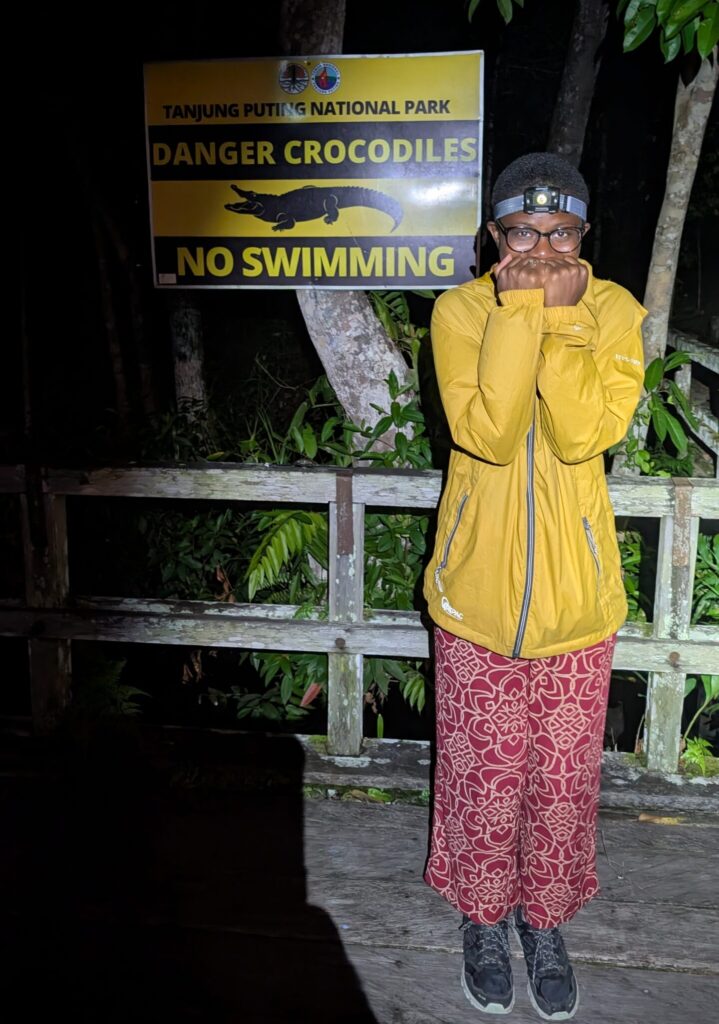
While the park has plenty of dense primary and secondary rainforest, this tour sticks to the feeding stations. These comprise of some swampy areas, managed patches of forest and some stuff alongside the river. So don’t expect deep jungle treks with towering 30-meter trees and Tarzan-worthy vines. Most of your time on land will be spent at the stations, or ‘camps,’ watching orangutans munch on fistfuls of sweet potato.
That said, what you do see outside of the camps is still stunning. Especially when cruising the tree-lined river at dusk!
Rehabilitating the Jungle Red-Heads
The ‘International Orangutan Foundation’, based in the park, works to rehabilitate orangutans impacted by the ongoing palm oil frenzy. Sadly, young Orangutan are often found near mothers killed by deforestation (usually by fire), or in the hands of unsavoury individuals. For decades, the foundation has cared for these animals and released them into the park.
Despite their efforts, orangutan numbers are still declining – depressing, I know. And, as far as I understand, the Sumatran species is in considerably worse shape. Stupid humans.
Loud, Fumy & Beaten up: What is a Klotok?
Across Indonesia, each region has its own boat style (there’s even a fascinating museum about this in Jakarta!). In Kalimantan, they use Klotok boats – simple wooden vessels powered by a loud, grumbling diesel engine somewhere deep in the hull. They’re slow and sit oddly low in the water, but they look fantastic cruising upriver. Originally they were used to transport people and goods, but they’ve been adapted to cater for ‘liveaboard’ river tours.
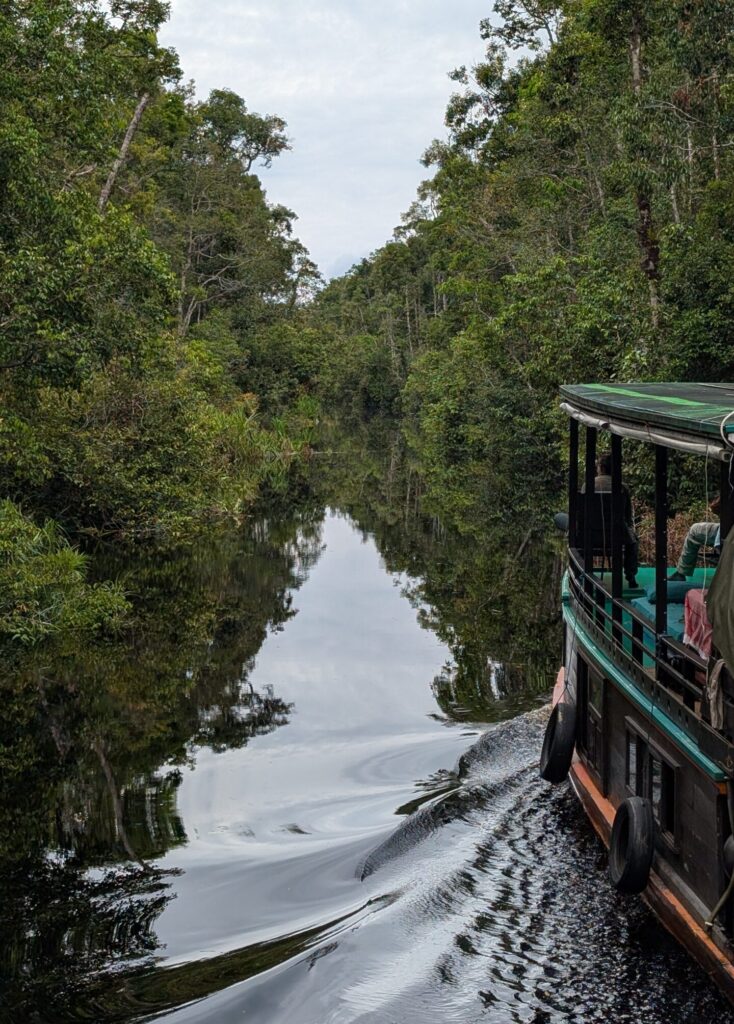
They have 2 or 3 open-sided decks where you’ll sleep, relax, eat, and sightsee. Tables, chairs, mosquito nets, and mattresses are crammed into every available nook or cranny when not in use. Before meals or bedtime, the crew somehow transforms the decks at lightspeed into a dining area or hotel room – well, a very basic one. It’s just a row of mattresses on the floor with mosquito nets draped over!
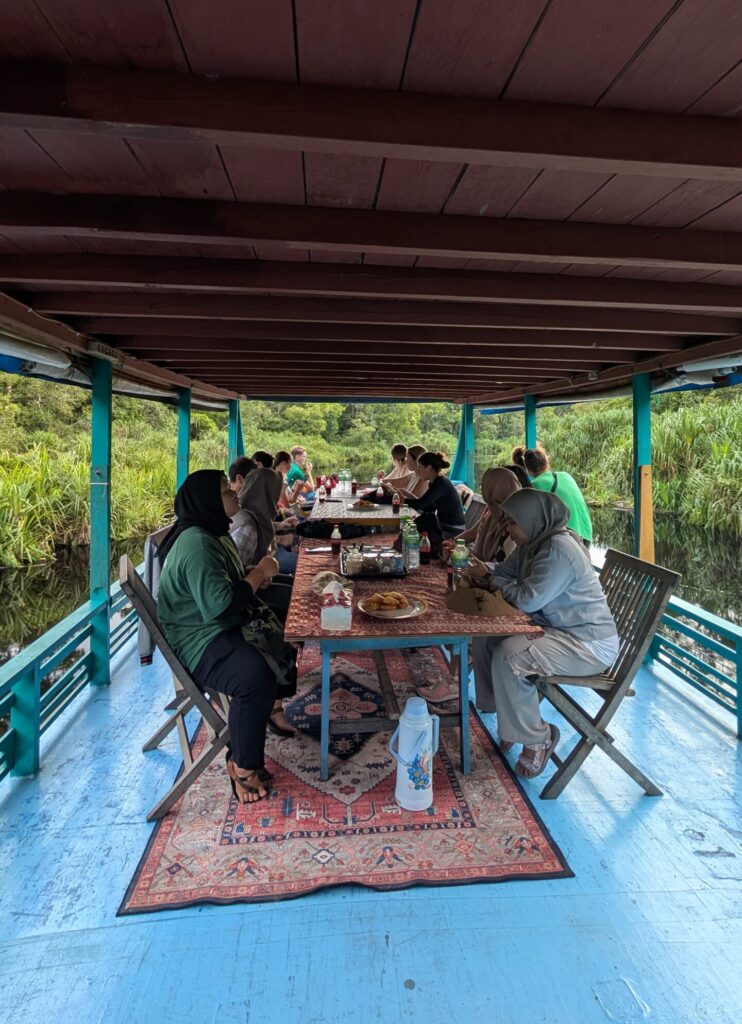
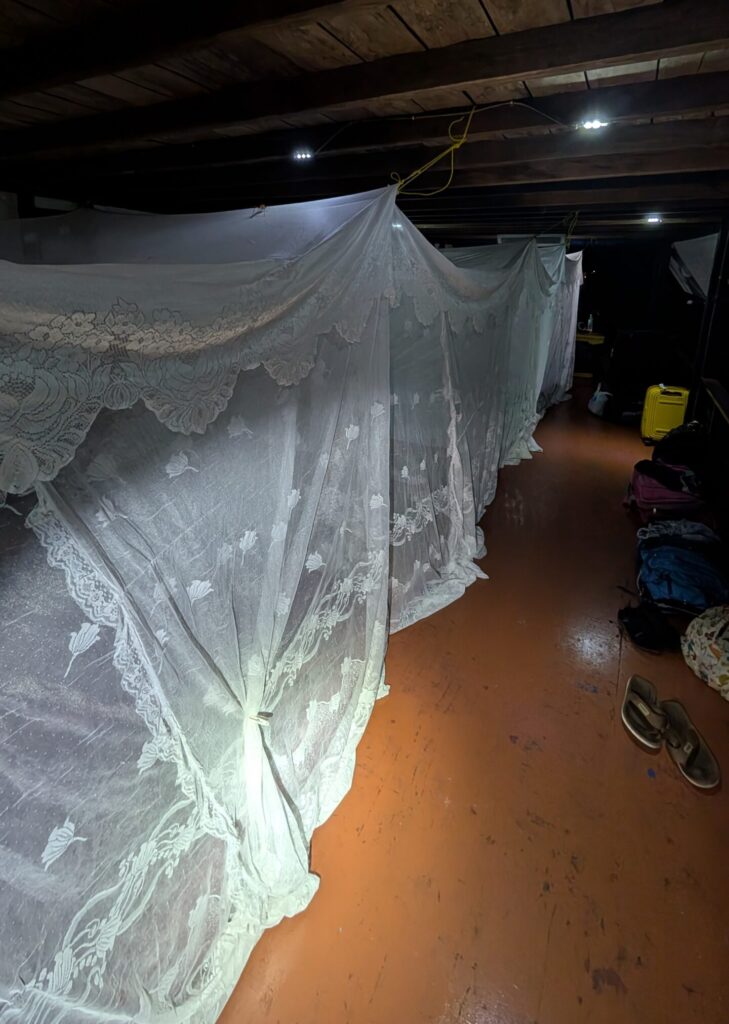
The toilets are ‘marine style,’ meaning they empty directly into the river and are flushed manually with pale of river water from a nearby water butt. If you choose to shower (admittedly, I didn’t), you’ll use the same pale. Although, some boats do have basic showers when the engine is running. Oh, and by the way, the water you use is from the river, as is the water they cook and wash dishes with…
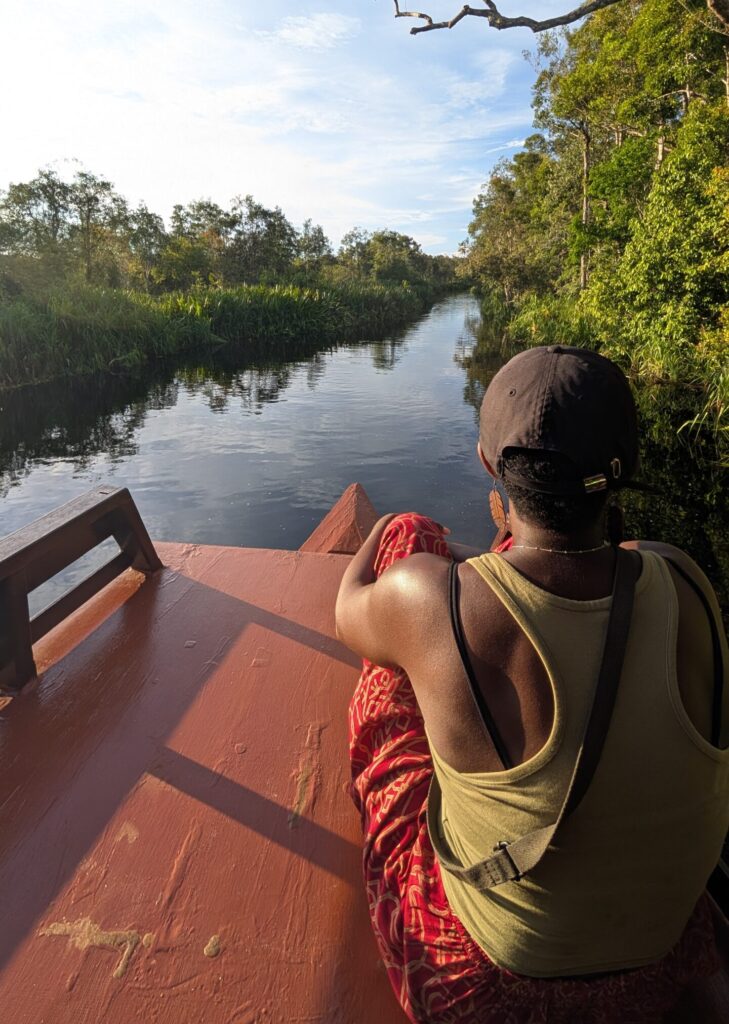
Which leads me to my next point – the water is pitch black. It’s like floating on rippling obsidian, or tar! The colour comes from tannins leaching into the water from the surrounding roots and leaf litter. But, when you scoop some up, you’ll see it’s actually a dark reddish-brown.
Pot wash? More like Foot wash!
You know when you accidentally see something, but you really wish you hadn’t? Somethings you can’t unsee. Well, brace yourself… You won’t be able to unread this!
The meals on the Klotok were amazing, especially given the tiny kitchen! It’s a pantry sized, engine-fume-filled space with a wooden bench, a broken children’s plastic table, and a camping stove. But despite this, somehow three times a day they served up feasts: rice, noodles, eggs, veggies, fish, and even tofu or tempe, with fruit platters for dessert. A truly impressive feat that I never actually caught them doing.
However, one evening, I did catch them doing the dishes. Among other things…
The crew often gets distracted with hurling banter at each other across boats. So, on this occasion they didn’t realise I was standing close by, waiting for the toilet. Suddenly, the pot-washer stood up to bellow across the river, simultaneously stepping back into the plastic basin of dirty dishes. Then, he casually began scrubbing his feet among the mugs and cutlery! Now, I am all for water conservation, but I do wish he’d finished the dishes before moving on to himself!
I decided not to tell Mary-Ann and let her enjoy her final meals in ignorant bliss. Fortunately, I did not detect any cheesy flavours the next day, and no one got sick – phew!
The Tour Itself – Our Account
Day 1 – A Mushroom and Some Other Stuff
After landing at Pangkalan Bun airport, we had to wait about 2 hours for the other tourists to arrive via various transport modes. We weren’t warned about this, so our tour didn’t start until late morning, which was a bit annoying. But once everyone was there, we were promptly taxi’d to Kumai, a small town on the river where the Klotok are moored and things progressed quickly. Once everyone was aboard, our group set off in convoy toward the park’s entrance. It’s not far—you pass the orangutan statue after just 15 minutes before heading to your first stop, ‘camp 1.’
Pro Tip – Wear good shoes for this first day. It may sound random, but getting from the roadside to the boat involves crossing some rickety, slippery ‘boardwalks.’ Then, once at the river, you might need to clamber over other boats to reach your assigned one. I did it in flip-flops, and let’s just say there were a few moments!
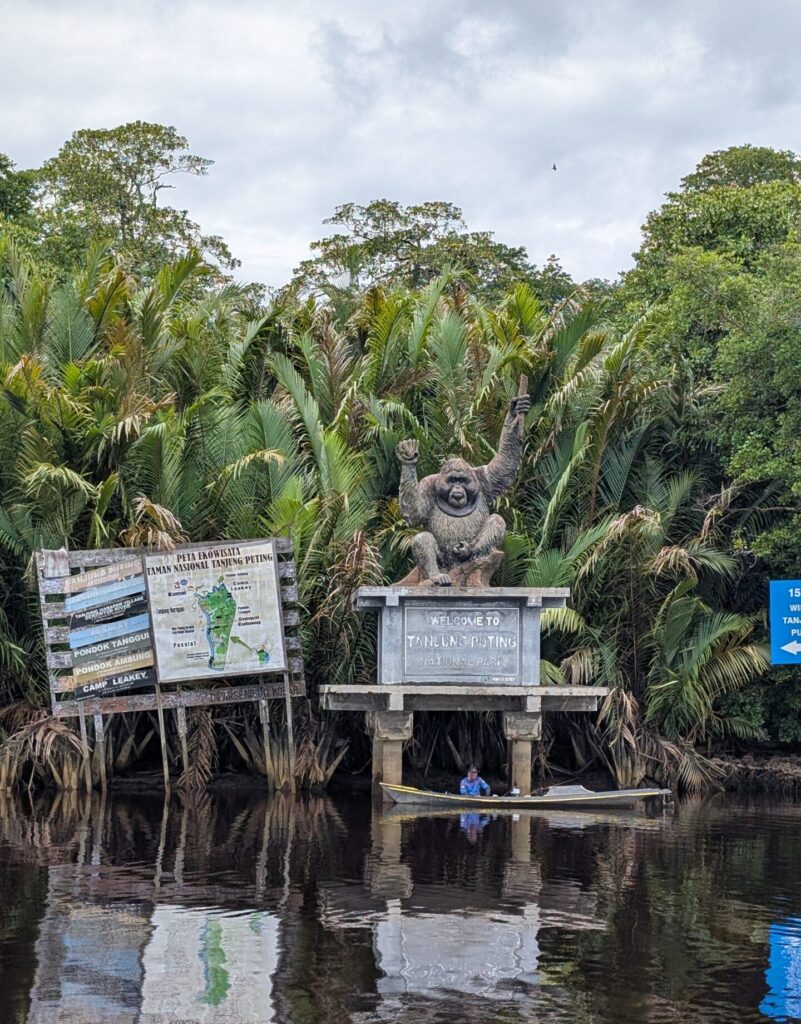
We ate lunch on the way while wondering how we’d all fit to sleep in such a small space. But even so, everyone was completely relaxed – which, was a novelty for us in itself. Our previous boat rides were mainly out at sea, with plenty of choppy waters and tense moments. This time, though, it felt like drifting on the wind, surrounded by incredible nature and the occasional wild orangutan! We caught a glimpse of a couple, but it’s not a guarantee.
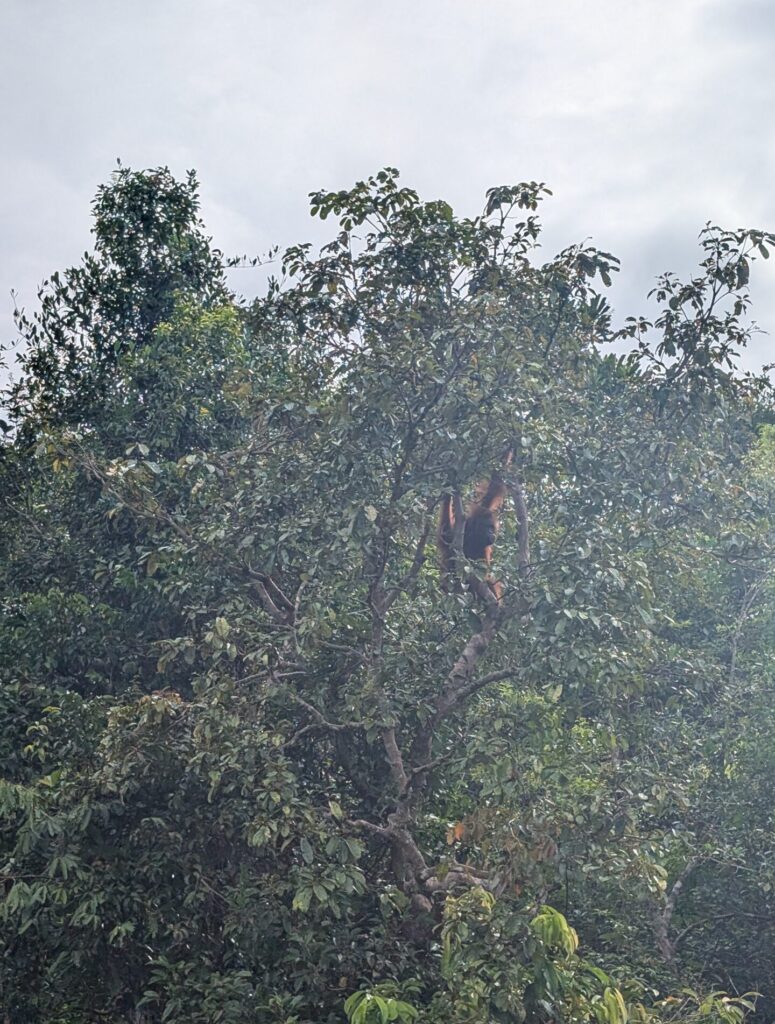
Camp 1
After a few hours, we arrived at Camp 1 and headed to the first feeding station. There were a few other tourists, but not too many—just how you want it when quietly watching wildlife! Fortunately, the alpha male (AKA Rodger, a 41 yr old released in the 90’s) showed up for a snack. He lazily claimed the feeding deck, while 4 or 5 others waited patiently in the trees for their turn!
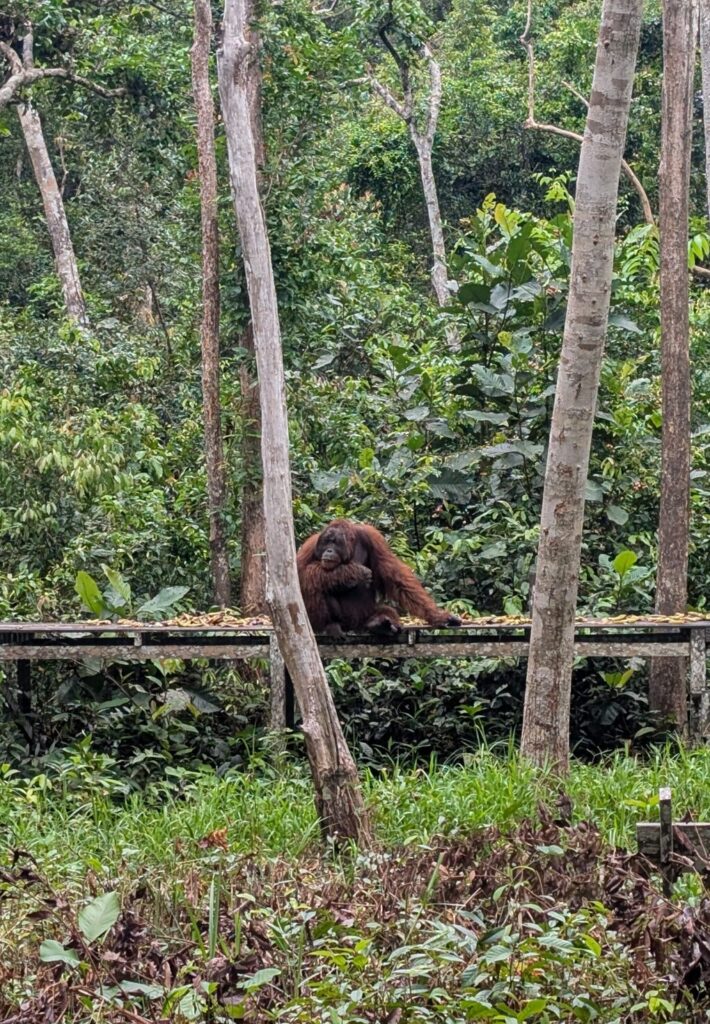
We watched for about 40 minutes before heading back to the boat for a dusky cruise up the river to look for proboscis monkeys. Unfortunately, we didn’t spot any that evening, but we did see macaques and plenty of birdlife. Honestly, the best part of the trip was just drifting on the mirror-still river in the cool evening air. It felt almost surreal.
Once back, the crew needed time to turn the boat into a hotel and finish dinner. So, we were handed over to local rangers for a night safari, on a 1km walk through the jungle. We spotted birds, a snake, frogs, and some strange insects. But the highlight? A glowing mushroom! I know, I couldn’t believe it either! I can die happy now.
I’m not sure why, but the night walk seemed to affect Mary-Ann. From that evening on, she felt like Rodger was lurking in the dark, watching us, as if he’d jump out at any moment… I reckon she might have secretly eaten one of the mushrooms!
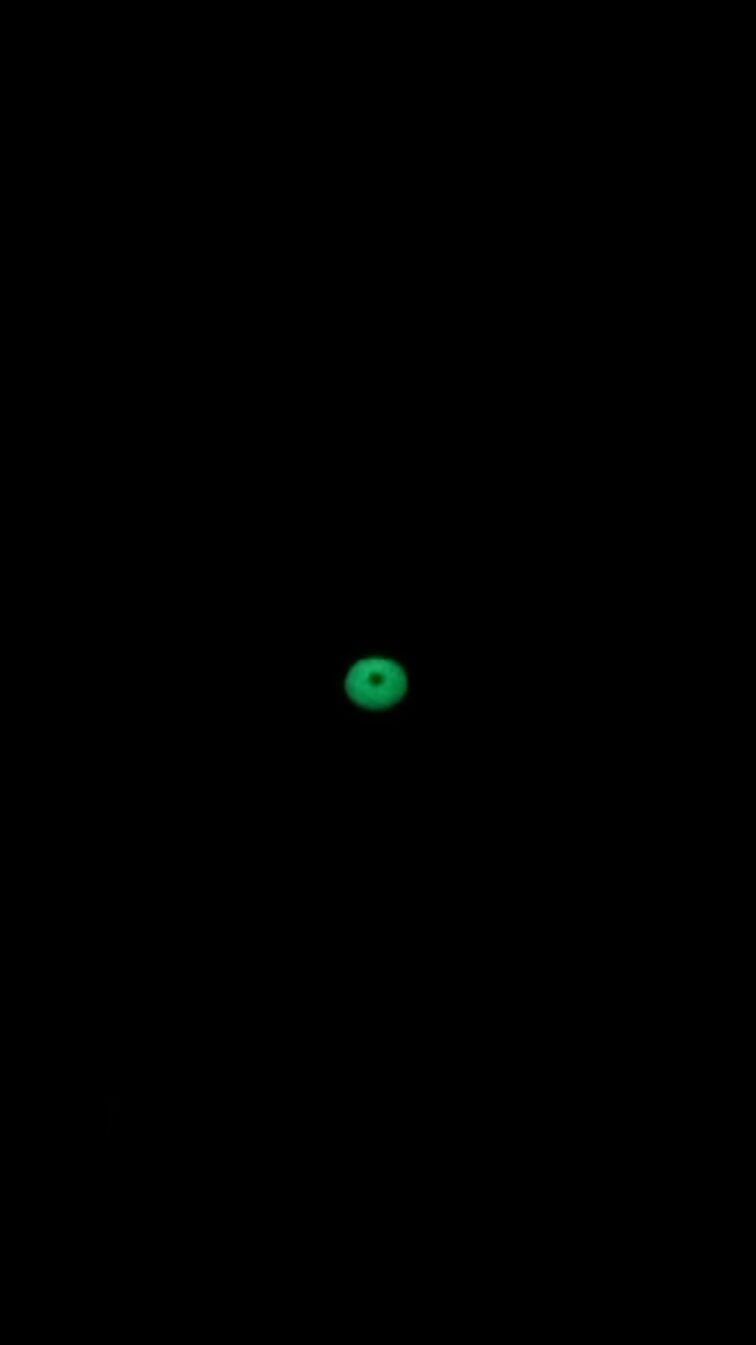
Next, with the night walk done, all that was left was dinner under the stars, then bed. Overall a lovely day, made even better by an adorable family of cats!
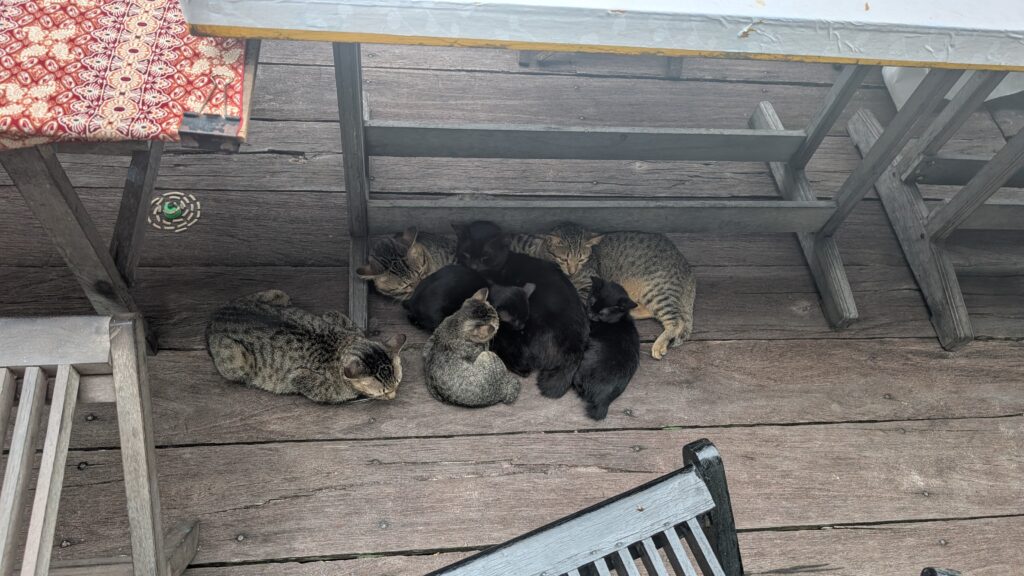
Day 2 – Big Noses and a Wise Old Doctor
Camp 2
After waking up the huddle of cats and having breakfast, the crew ‘Tetris-ed’ the beds, chairs, and tables away, and we set off deeper into the jungle. Our first stop came a couple of hours later at ‘Camp 2,’ the next feeding station for a different group of orangutans.
A Surprise Foot Bath
Communication, or the lack there of, was an ongoing theme in Indonesia. Actually, it became somewhat of a running joke between us and a few other tourists…
At camp 2, we were the last to hop off the boat onto the rickety dock, and quickly noticed everyone was in shorts and flip-flops. We thought nothing of it, because as instructed on day 1, we had worn shoes and trousers to help with ‘rough terrain and insect bites’.
“Looks like you were the only ones not to get the memo,” one guy said. He was part of the communication joke crew, so we assumed he wasn’t serious and carried on.
Five minutes later, we had weaved to the front of the group, even passing the tour guide – thanks to our lovely supportive trainers! But then, suddenly there was water. A lot of it.
It turned out the guy wasn’t joking… We were the only ones the guide didn’t warn about the knee-deep swamp between us and the orangutans!
With no time to change, we rolled up our trousers and went barefoot. Imagine squelching through opaque black, jungle swamp water with no shoes on… It was squishy, to say the least. Am I the only one who finds the feeling of slimy stuff between my toes a little bit sickening?
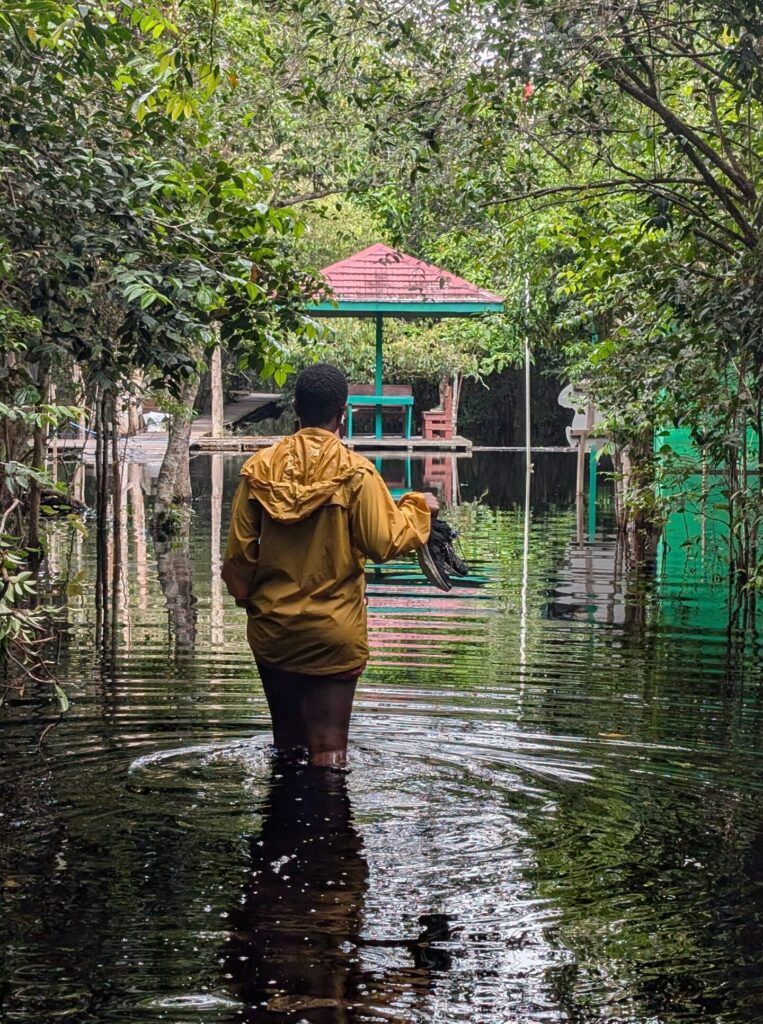
On the short walk from the boat to the viewing point, we could hear someone whooping loudly in the distance, over and over.
“Ah, that’s just someone having an argument with the orangutans,” I joked to Mary-Ann.
Well, I wasn’t far off! On that particular day, the apes weren’t hungry and hadn’t shown up for their feed. So, for the benefit of the tourists’, the rangers were politely shouting for them to come grab a snack. It’s worth noting the feeding stations are primarily there to supplement the animals’ diets, as they don’t have enough forest range to roam freely due to deforestation. Of course, they also benefit eco-tourism – us hairless monkeys are easy to please.
Anyway, after many booming “whoops,” one member of the group eventually arrived and had the entire banana mountain to herself. She couldn’t eat them all, so the local macaques seized the moment and got involved.
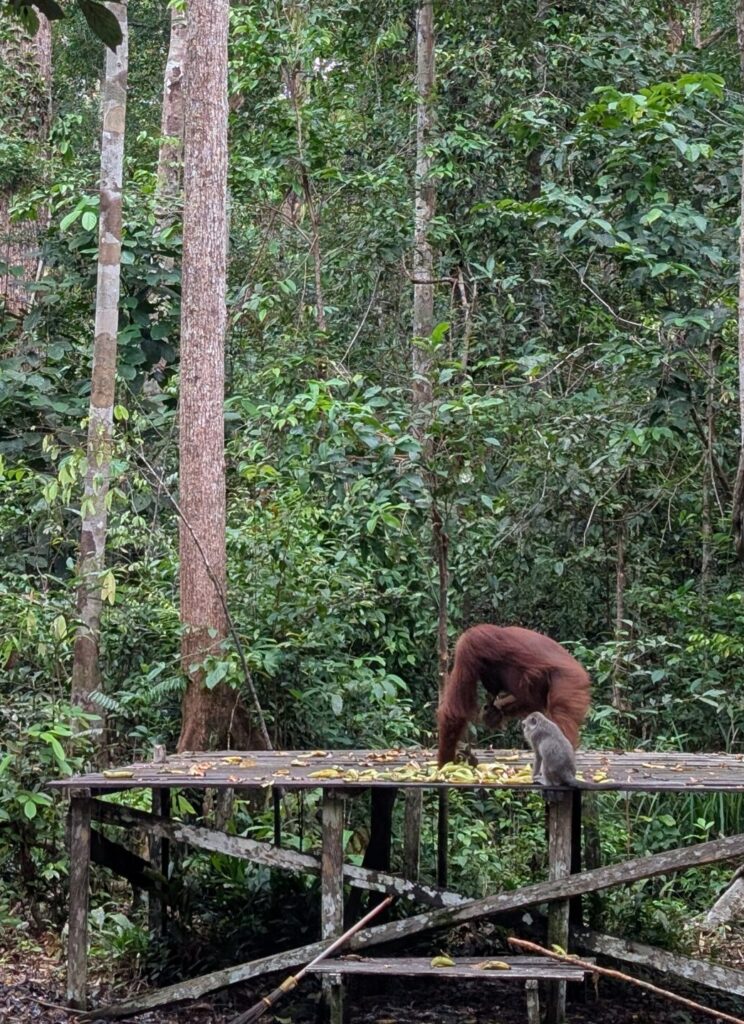
Camp Leaky
I’m not sure why it isn’t called ‘Camp 3,’ but after finishing up at the second feeding station, we headed to Camp Leaky, the deepest feeding station tourists can visit. We ate lunch enroute, sat back and just enjoyed the journey – the forest just gets better and better the deeper you go.
Once there, we disembarked and walked straight to the final feeding station. Camp Leaky is the main station, home to the research centre and a few other buildings. It’s also where the three founders based themselves decades ago, and where the current (somewhat smaller) team resides.
It was perhaps our favourite feeding station experience – we saw at least 3 mothers with babies in tow. It was hilarious watching the slightly hyper, uncoordinated ‘toddlers’ farting about while the mothers kept an ever-watchful eye on them.
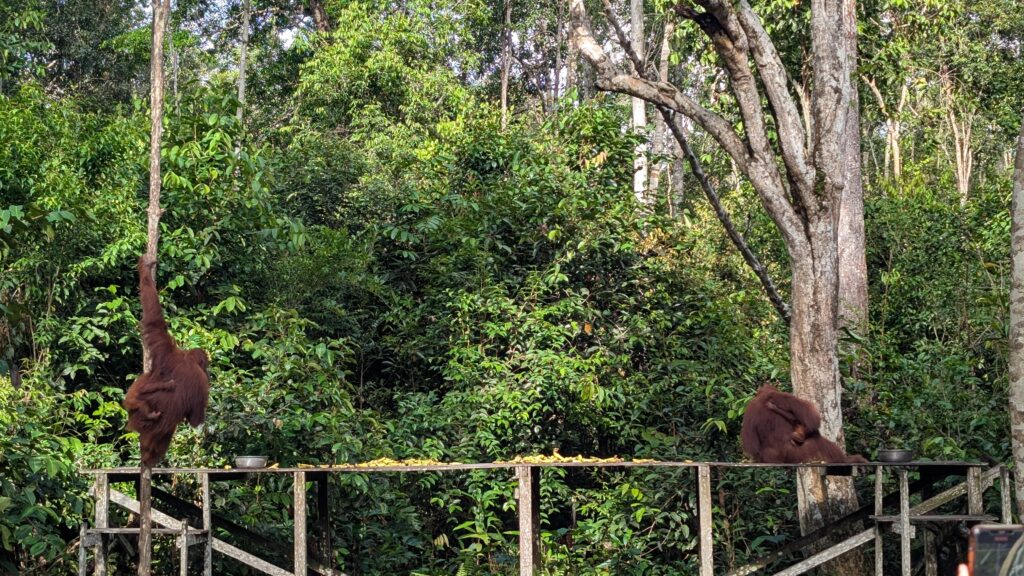
After watching for nearly an hour (it just never got boring), we were beckoned back to the boat by the guides. But before we made it, unbelievably, we stumbled across Dr. Birutė in the flesh! Despite her age and frailty, she still makes the trip into the forest from time to time – very impressive. She and a current volunteer were talking to a mother orangutan and her two children in a tree next to them… Perhaps about the weather?
Many moons ago, Dr. Birutė had worked with the adult orangutan’s mother, so there was a kind of ‘generational trust’ between them. This became very clear when Mary-Ann and I approached, as the older of the two children became quite irritated and even threw a stick at us. Which is quite understandable, I’d throw things at me too… At least it wasn’t poop.
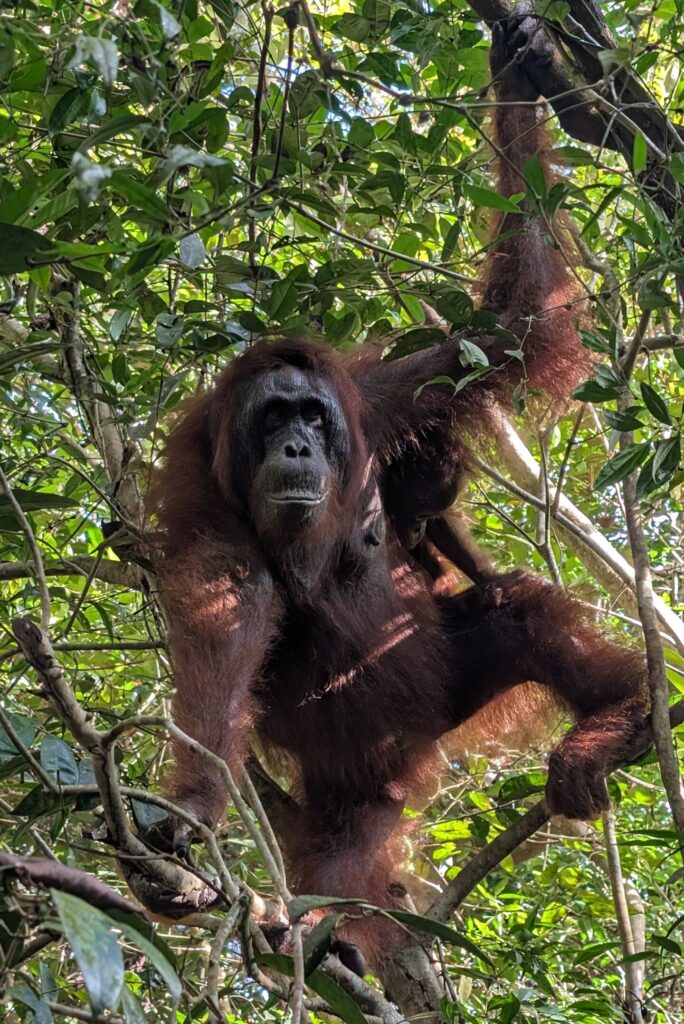
After a brief but incredibly amazing impromptu Q&A, Dr. Birutė and her monkey friends left, and we headed back to the boat. The final excursion of day 2 was to head slightly deeper into the jungle to see fireflies; something I’d wanted to see for a long time!
Spoiler alert: we saw no fireflies. But, on the way, we did spot a troop of proboscis monkeys!
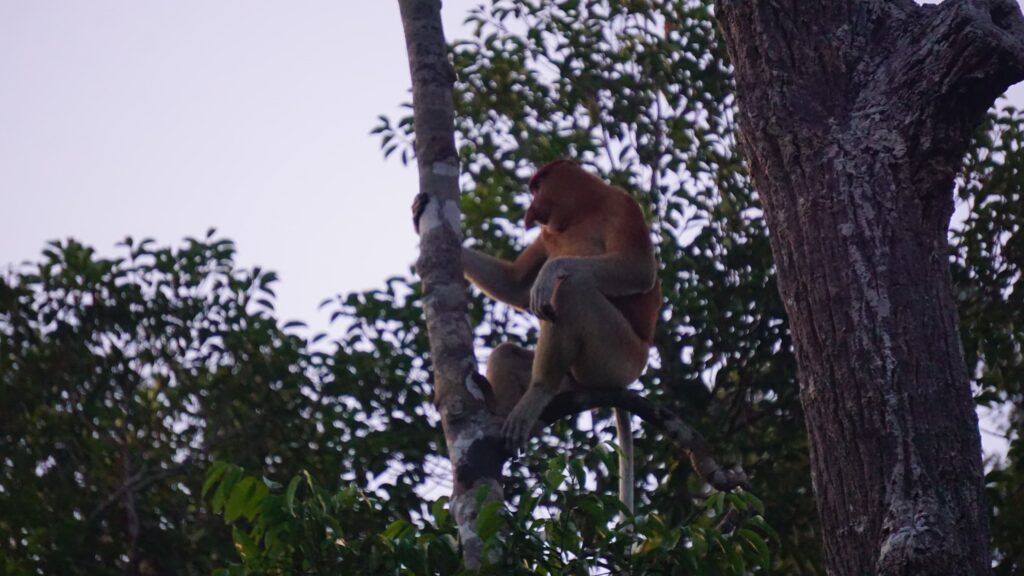
The ‘Grassberg’
If you read my Raja Ampat blog, you’ll know we have a bit of a curse when it comes to boats. And on this occasion, it manifested in form of a massive floating chunk of grass! Well, it also had logs, reeds, mud, roots, and possibly some snakes and crocodiles inside too! It was so big, it looked like the river had come to a dead end.
As absurd as a giant grass-berg seemed, it also didn’t seem entirely out of place in a jungle river at the beginning of wet season. So we assumed this was just another day in the life for the boat crew, however we were wrong to make that assumption…
Their plan was simple – back up a bit, then drive at it at top speed and hope we get through!
We ended up beached on the floating mass, with our propeller completely snarled in the reeds and roots. To make things worse, we were the first boat in a queue of about five, all waiting to see fireflies. When I asked our guide if this had ever happened before, his response was simply, “No, not ever!” followed by a facepalm and hysterical laughter… It was pretty funny I guess!
But after 4 hours of haphazardly using machetes, tow ropes and some brave (or idiotic) diving into the abyss, we still hadn’t freed ourselves. In fact, at this point we were holding up some of the rangers, who were trying to get by in a smaller boat.
We did eventually get free, but it was far too late to press onward to see the fireflies. Many people had already gone to bed by the time we were finally sailing again!
Day 3 – Well… It Wasn’t Exactly a Day!
I’m not sure if it was the Grassberg fiasco or if the tour always wraps up this early, but we were back in Kumai by about 9AM. Honestly, that was a bit frustrating. If a tour is advertised as ‘3 days,’ I expect it to be closer to 3 days than 2!
Anyway, we said our goodbyes to the crew and were promptly whisked off to the gift shop in Pangkalan Bun (of course). We spent about an hour there while everyone wrapped up their shopping before being dropped off at our respective hotels or the airport.
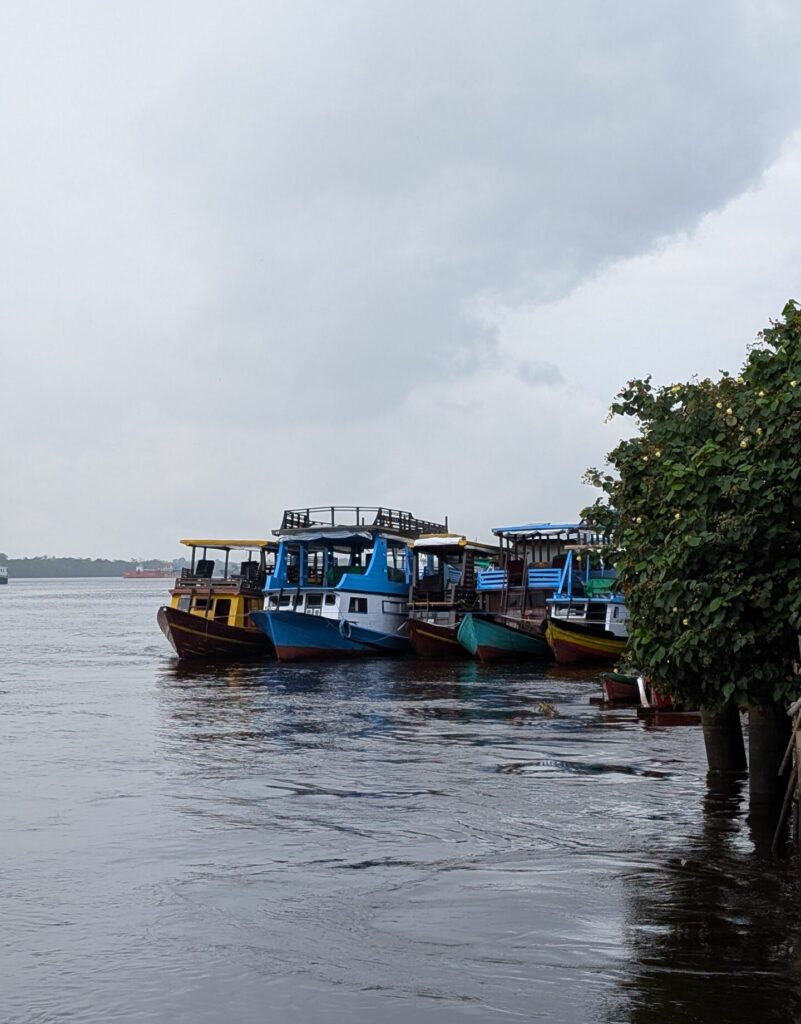
The problem was that the flight most of us were waiting for wasn’t due until mid-afternoon. We had hours to kill, and the area isn’t exactly a hive of activity! For reasons I can’t quite remember, we decided to take a 2-hour ‘city tour.’ But, I highly recommend you don’t do the same. It was laughably bad… So bad, I kind of enjoyed it. The ‘sites’ were mostly closed, the ‘local food’ tasting was at additional expense and was terrible, and finally, the ‘30-minute river cruise’ was more like 10 minutes of absolute nothingness… Oh, and it was raining on and off too!
Pro Tip – If you’re stuck in Pangkalan Bun for a few hours, make your way to Kahawa Coffee Roastery – it’s a lovely spot with great coffee! Or, you could try heading to the Mercure Hotel and ask about a day pass for their pool and bar facilities – it’s supposed to be quite nice!
Final Thoughts – Was it Worth it?
Although technically another liveaboard tour, this one was worlds apart from our journey between Lombok and Flores. It felt just as wild and intrepid, but at a much slower, calmer pace. Watching the feeding stations and floating for hours on the glassy black river was an incredibly cathartic experience.
By the end of our first liveaboard, we were sad to leave but also completely exhausted, mentally and physically. This time, though, even though we were sticky, smelly, and gross, we almost felt rejuvenated. The whole trip felt like a wellness retreat! All we really had to do was sit back and watch the jungley world go by.
Now, let’s talk about value for money… per person, per day, this came in at about £60 (not including getting to Kalimantan). So, slightly more than our first liveaboard, but still a great deal in my book. I mean, where else can you float down a river in Borneo to watch orangutans?!
The only other places to see these iconic, hairy orange apes in the wild, is in Sumatra (which has a different species of orangutan), and the Malaysian side of Borneo. I’m told both are great, but neither are done by boat! So, for that reason alone, my vote goes to Tanjung Putting. It’s totally worth it and should feature on your Indonesia itinerary! I would even suggest that, if possible, go for the longer tour – 4 days, 3 nights!
Stay bald folks.
Toodles,
Jack

